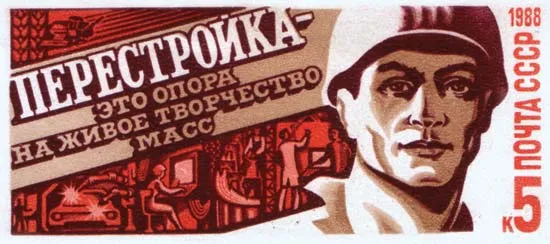Breathing New Life into a Struggling System
Imagine the Soviet Union in the 1980s: a global superpower outwardly, but internally grappling with a stagnant economy and disillusioned populace. Enter Mikhail Gorbachev, whose daring plan to resuscitate the USSR hinged on two key reforms: glasnost and perestroika.
Think of glasnost as opening a window to let in fresh air. It represented a move towards transparency and freedom of expression. Previously, open criticism of the government was unthinkable. However, Gorbachev believed that encouraging open dialogue, even dissent, was crucial for progress. This meant loosening censorship, allowing greater freedom in media and arts, and even releasing political prisoners.
Perestroika, on the other hand, was akin to renovating the entire house. This reform tackled the ailing Soviet economy. Instead of the government controlling everything, perestroika allowed for a taste of free-market principles. Small businesses emerged, existing industries gained more autonomy, and a degree of competition was encouraged.
The two reforms were designed to work in tandem. A more open system (glasnost) would, ideally, foster public support for the drastic changes perestroika brought.
However, like any major undertaking, there were unintended consequences. Greater freedom of speech meant greater expression of discontent, especially when perestroika didn’t magically resolve all issues. Additionally, the surge in nationalism that followed glasnost led different Soviet republics to assert their identities more forcefully.
The impact of glasnost and perestroika is still debated among historians. Did they directly cause the Soviet Union’s collapse? Or were they simply catalysts in a complex web of factors? What is undeniable is their role in shaping a pivotal moment in history: a superpower’s attempt at peaceful, internal transformation, resulting in the fall of the Berlin Wall, the end of the Cold War, and eventually, the dissolution of the Soviet Union itself.
Glasnost vs. Perestroika: A Simple Breakdown
Let’s break down the differences between glasnost and perestroika, especially for those encountering these terms in resources like Quizlet.
Glasnost = Openness:
- Focused on social and political liberalization.
- Increased transparency and freedom of expression.
- Examples: Relaxed censorship in media, arts, and public discourse.
Perestroika = Restructuring:
- Primarily focused on economic reforms.
- Introduced limited free-market mechanisms and decentralization.
- Aim was to revitalize the Soviet economy.
Gorbachev hoped these reforms would bolster the Soviet Union, but they may have inadvertently hastened its demise. Glasnost gave citizens a voice to air long-held grievances, while perestroika, despite good intentions, led to economic instability and shortages, further fueling dissatisfaction.
Glasnost and Perestroika: Two Sides of the Same Coin?
While often mentioned together, glasnost and perestroika were distinct policies enacted by Mikhail Gorbachev in the mid-1980s to revive the struggling Soviet Union. Think of them as two sides of the same coin – both crucial for reform, but with different approaches and goals.
Glasnost, meaning “openness,” aimed to give the Soviet people a voice. It chipped away at censorship, allowing for greater freedom of expression in media, arts, and public discourse. The goal was to empower citizens and hold the government accountable.
Perestroika, meaning “restructuring,” targeted the stagnant Soviet economy. This policy introduced market-oriented reforms, allowing for things like cooperatives and joint ventures with Western companies. The goal was to boost the economy and make it more globally competitive.
Glasnost’s push for openness and transparency was essential for perestroika’s economic reforms to take root. However, the exact role these policies played in the Soviet Union’s 1991 collapse is still debated by historians. Some argue that the increased freedoms of glasnost contributed to the Soviet Union’s demise, while others contend that perestroika’s economic reforms were not effectively implemented to salvage the system.
The interplay of glasnost and perestroika, alongside numerous other factors, ultimately contributed to the dramatic transformation of the Soviet Union. This period continues to fascinate scholars and reminds us of the profound and often unpredictable impact political and economic reforms can have on a nation’s trajectory.
What is Glasnost in Simple Terms?
Imagine a society where you couldn’t openly express your opinions, where the government controlled all information. That was the reality in the Soviet Union before Gorbachev’s glasnost, meaning “openness” in Russian.
Gorbachev believed that for the USSR to progress, its citizens needed a voice. Glasnost aimed to dismantle the culture of secrecy and censorship that had permeated Soviet society for decades. It encouraged open discussion and debate, even criticism of the government – a radical departure from the past.
With glasnost, newspapers could publish articles questioning government policies. Artists could create works challenging the official Soviet ideology. Citizens could openly debate the country’s future.
This newfound openness had a significant impact. By allowing people to talk about problems, glasnost paved the way for addressing them. It shone a light on issues like corruption, inefficiency, and social injustices that had been festering for years.
While it was a gradual process, and not without resistance, glasnost marked a turning point, forever changing the fabric of Soviet society.
Perestroika & Glasnost: Understanding a Pivotal Moment in AP World History
By the mid-1980s, the Soviet Union faced serious challenges: a stagnant economy, technological stagnation, and a populace yearning for freedom and openness. Mikhail Gorbachev, the last leader of the Soviet Union, believed in reform and revitalization. He pinned his hopes on two key policies: perestroika and glasnost.
Perestroika, roughly translating to “restructuring,” aimed to breathe life into the Soviet economy. Gorbachev recognized that the old, rigid system of central planning wasn’t working. He proposed reforms to loosen the government’s grip on the economy and introduce elements of a market system. These included allowing some private businesses, encouraging foreign investment, and giving local factories more control.
Glasnost, meaning “openness,” aimed to dismantle the Soviet Union’s culture of secrecy and control. It went beyond free speech, empowering citizens to criticize their government and leading to a surge in public debate and dissent.
These reforms, though well-intentioned, had unintended consequences. Perestroika’s economic restructuring led to shortages and economic hardship, fueling public discontent. Glasnost, while liberating, also unleashed long-suppressed nationalistic sentiments and calls for greater autonomy from the various republics within the Soviet Union.
The legacy of perestroika and glasnost is still debated. Some argue that while they ultimately contributed to the Soviet Union’s collapse, they also planted seeds for democracy and freedom in former Soviet republics. Others contend that their rapid and poorly managed implementation created more problems than they solved.
Regardless of perspective, perestroika and glasnost were pivotal moments in the history of the Soviet Union and the world. They remind us that even the most entrenched systems are not immune to change and that the pursuit of openness and reform can have both intended and unintended consequences.
Key Points:
- Glasnost (openness):
- Encouraged transparency and freedom of expression
- Loosened censorship and released political prisoners
- Perestroika (restructuring):
- Overhauled the Soviet system, particularly the economy
- Allowed for limited free market experimentation and increased business autonomy
- Goal:
- Open up the system (glasnost) to foster support for major changes (perestroika)
- Unintended Consequences:
- Increased public discontent and nationalism
- Contributed to the fall of the Soviet Union
- Historical Significance:
- Pivotal moment in world history
- Exemplified a superpower’s attempt at peaceful internal transformation
Interested in knowing more about the colonies? Click here
Do you know about Elizabeth Bacon Custer? Click here to know more.
Want to know about Yankel Rosenbaum? click here
Want to read more about Tyquaez Pickett, Click here
















